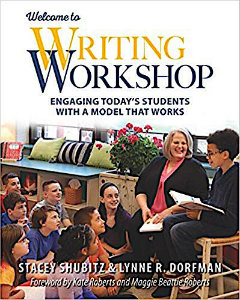Writing Workshop for 21st Century Students
Welcome to Writing Workshop: Engaging Today’s Students with a Model That Works
By Stacey Shubitz and Lynne R. Dorfman
(Stenhouse, 2019 – Learn more)

Welcome to Writing Workshop: Engaging Today’s Students with A Model That Works offers a writing resource blueprint for the K-6 classroom.
The advice, routines, tips, tools, and videos provided help to create a shared writing experience for the students and teacher. And the workshop setting allows students to develop a writing identity along with the mindset of being a writer.

The idea is that students write daily and in time are able to choose what pieces they want to develop through to publication. Most important, students will learn that it is okay to choose to abandon a particular piece, and have a choice in what writing pieces will be submitted for a grade.
The core idea is for students to gain an intrinsic sense of pride in their work and develop good habits as writers.
The authors believe in working with each student within their Zone of Proximal Development (Lev Vygotsky, 1986), as well as using the “I do, We do, You do” model of gradual release. Video clips are provided based on chapter topics such as “The Exhilaration of Writing Workshop” and “A Rationale for Writing Workshop from a Principal’s Perspective.” Early in the book, the authors share common terms they will use throughout the text as well as the four types of writing features — preparing readers to move further into this workshop approach.
Writing as a shared experience
The writing community and the importance of student attitude toward writing is clear throughout as Shubitz and Dorfman see the writing classroom as a shared experience. Sharing ideas, problem solving, and strategies, as well as style and voice, are key factors in the success of young writers.
They stress the need for teachers to provide students with daily, uninterrupted time to write, share, confer, and collaborate. Mentor texts are deemed important tools, but the student’s own published writing is to be viewed as “important and necessary to move their writing community forward” (Dorfman and Cappelli 2017, pg. 41).
Just as significant in this workshop approach is the teacher as a writer, stated as “an essential ingredient to success” (pg. 45). The teacher should be a role model, writing in front of their students, sharing ideas, and working through the writing process just as the students would to develop their writing.
As a teacher who writes, I find my visible act of writing sets the tone for our classroom environment. I also follow their recommended practice of having the teacher keep a writer’s notebook and write just as frequently as the students, creating respect for the writing time.
Several resources are provided throughout the book. Aside from the video clips, the authors include QR codes and tools such as “Conferring with Writers Cheat Sheet,” “P.O.P. Technique,” ideas for conference record keeping, and ideas for conferring “toolkits,” as well as whole group and small group mini-lessons.
Making room for grammar, conventions and spelling
Chapter 10 offers “Strategic Instruction in Grammar, Conventions, and Spelling.” One main message that stands out in this chapter is “Students need to understand that writing going out to the public must be clearly communicated by choosing words carefully to carry their ideas and by checking grammar, usage, and conventions” (pg. 150).
Other topics covered include “Daily Oral Language,” “The Sounds and Rhythms of Language,” “Poetry and Song Lyrics as Mentor Texts,” “Spelling Instructional Strategies for the Classroom Teacher,” and “Strategies for Self-Editing.”
A “Spelling Strategies Self-Assessment” is included to help students self assess the spelling in their writing, and a “Time to Start a New Paragraph” chart suggestion is given. Again, focused video clips are included to reinforce these topics. Finally, in addition to the resources offered throughout this book, the appendices include other tools to support the writing workshop.
Overall, I like the blend of old school writing workshop structure with the infusion of 21st century resources and ideas. Environment, student attitude toward writing, student choice, and writing teachers who write are overarching themes that help to make this book a good resource for implementing a productive writing workshop.
Kathleen Palmieri is a fifth grade teacher in upstate New York who reviews regularly for MiddleWeb. With a passion for literacy and learning in the classroom, she participates in various writing workshops and curriculum writing endeavors. As a lifelong learner, she is an avid reader and researcher of educational practices and techniques. Collaborating with colleagues and globally on Twitter @Kathie042500 is an ongoing practice.






























